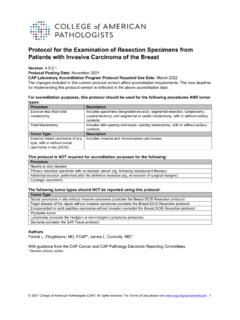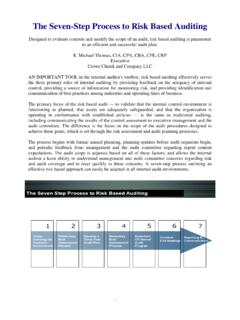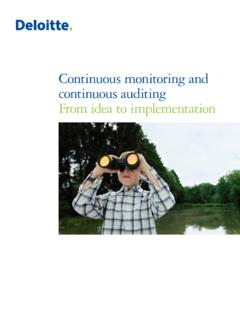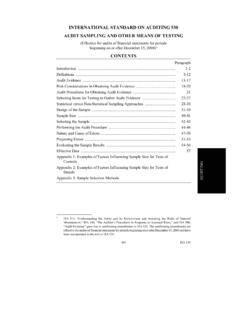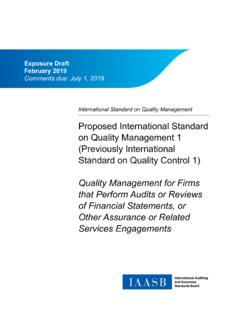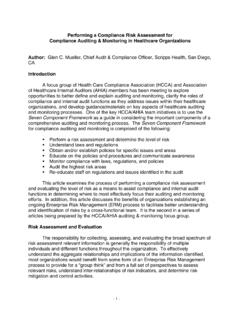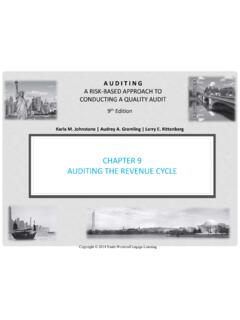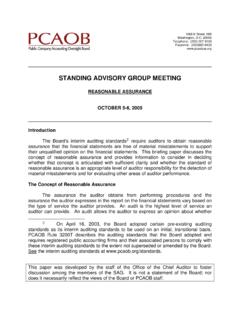Transcription of Risk Management Guide - College of American Pathologists
1 Risk Management Guide ISO 15189 Accreditation Program 2 December 2015 CAP 15189 CAP 15189 BackgroundThe ISO 15189:2012 standard includes a clause regarding risk Management ( ). The text reads: The laboratory shall evaluate the impact of work processes and potential failures on examination results as they affect patient safety, and shall modify processes to reduce or eliminate the identified risks and document decisions and actions taken. To clarify the laboratory s responsibility and the CAP s assessment standards, the CAP has developed this Guidance SummaryISO 15189 assessors from the CAP will ask to see risk assessments of any new or significantly revised processes implemented in the laboratory. Assessors may also ask to see evidence of an ongoing program of risk Management ; this includes activities such as internal audits, occurrence Management , proficiency testing (PT), and quality control (QC).
2 Assessors will evaluate the effectiveness of the laboratory s risk Management activities in light of all findings from the assessment, including corrected results, internal audit results, occurrence Management data, and customer DefinitionsTERMDEFINITIONF ailure ModeThe manner in which a process could potentially fail (ISO/TS 22367)FMEAF ailure Mode and Effects AnalysisProcess OwnerPerson who has the ultimate responsibility for the performance of a process in realizing its objectives measured by key process indicators, and has the authority and ability to make necessary changesRiskCombination of the probability of occurrence of harm and the severity of harm (ISO 14971)Risk AnalysisSystematic use of availiable information to identify hazards and to estimate the risk (ISO 14971)Risk AssessmentOverall process comprising a risk analysis and a risk evaluation (ISO 14971)Risk EvaluationProcess of comparing the estimated risk against given risk criteria to determine the acceptability of the risk (ISO 14971)Risk ManagementSystematic application of Management policies, procedures and practices to the tasks of analyzing, evaluating , controlling and monitoring risk (ISO 14971)Work ProcessSet of interrelated or interacting activities which transform inputs into outputs (ISO 15189) 3 CAP 15189 Risk Management GuideDecember 2015 Assumptions1.
3 Managing risks is not only a process, but a mindset that needs to be present throughout the laboratory. Laboratories need to create a risk Management culture. 2. Risk Management can be (1) a project triggered by an occurrence or finding, (2) a proactive project to evaluate potential weaknesses in a new, revised, or complex processes or (3) a continuous assessment based on daily events and observation of what is happening in the The risk Management process typically involves four key stages: A. Analyze the laboratory process: Understand it (typically through process mapping) and identify risk points. B. Evaluate risk points: Assess them based on probability and severity/impact.
4 Typically this takes the form of a matrix, and assigning a value to the risk. Here is an example of a risk matrix: Risk Matrix Example Note: Many laboratories find it helpful to provide further definition of the increments of probability and severity/impact. See Appendix A for an example of a scale of probability and severity/impact. C. Control risks : 1. Determine how to mitigate significant risks by changing the process. 2. Consider whether these risk control measures/process changes introduce new risks , and if so, address them. 3. Choose indicators or monitors that show whether the risk control plan is working ( , corrected reports, customer complaints, or TAT).
5 Note: Once the laboratory has taken these steps, it may need to revisit them. For example, the initial control measures/process changes may not have the desired effect. New measures may be riskAcceptable riskProbabilitySeverity 4 CAP 15189 Risk Management GuideDecember 2015 D. Monitor risks : Follow the data until you see a pattern of resolution based on the indicators chosen in step 3(c) above. Bring the risk down to the point where there are constraints ( based on available technology, or budget) that prevent you from reasonably bringing it down any further. There will always be some residual risk. 4. Work processes include more than laboratory tests. They also include processes from the pre-analytical and post-analytical phases, as well as support processes such as document control and procurement.
6 A laboratory s core and support processes are the basis for its internal audits. For an example of a laboratory s processes, see Appendix The most important target of risk assessment is core processes that directly impact patient care. Here is an example of such core processes: 6. Risk assessment is a requirement for IQCP. You may need to retrieve records and develop a current state for test groupings. For established test processes, you may have already completed much of this work (for example, with EQC data). PRE-ANALYTICAL ANALYTICALPOST-ANALYTICALTest orderingTestingResult reportingSpecimen collectionResult reviewArchiving specimen Specimen transportInterpretationSpecimen receipt 5 CAP 15189 Risk Management GuideDecember 2015 Routine Laboratory and Quality Team Activities that Reveal Risks1.
7 Internal Audits These are independent appraisals of work processes by someone who is: Not directly involved in the specific process or discipline Knowledgeable about the general technical domain Trained as an auditor Because audits involve direct observation, document and records reviews, and review of results, they can help you to identify many kinds of risks , for example: Rather than simply applying corrections (immediate actions to contain the nonconformance), such findings should be addressed with risk assessment, root cause analysis, and corrective Everyday Observation Being observant and aware of what is happening around you can identify risks .
8 For example: Seeing stained ceiling tiles, and recognizing that this may indicate a leak and/or mold, which could interfere with results Smelling diesel fumes, and recognizing that these are coming from intake vents near the loading dock Issues like these need to be assessed in terms of potential impacts on patient care, and their associated probability and severity. AUDIT FINDING/ NONCONFORMANCEDESCRIPTIONRESULTING RISKPROBABILITYSEVERITYM islabeled specimensThe specimen accessioning process is not identifying inadequately labeled will need to call physician and/or recollect sample, result-ing in potentially long delays in test results 34 Obsolete documentsThe document control process is not restricting access to obsolete activities may not be performed using the current , depending on process affectedRecurring errorsThe corrective action process is not preventing recur-rence of errors, or at least minimizing the will be perpetuated, potentially impacting patient laboratory staff safety and health31-5.
9 Depending on process affectedTemperature issuesThe refrigeration system is not effective in keeping temperature within a certain will not perform as 6 CAP 15189 Risk Management GuideDecember 2015 3. Occurrence Management Collecting, totaling, and analyzing occurrences can reveal risks . For example: Analyzing reporting distribution If you see that a few departments are reporting few or no occurrences, this does not indicate that everything is perfect. More likely, this represents a lack of commitment to reporting, a blind spot in the organization, and a high risk area. Performing root cause analysis The root cause of an occurrence may have the potential to impact many processes, not just the one in which the error or nonconformance occurred.
10 This identifies risks of additional nonconformances that may Proficiency Testing Analyzing PT results can help identify risks , even if the laboratory testing passes, and its testing status is not in jeopardy. For example: High level PT reports review patterns of outliers or failures. For example: o The number of analytes with outliers is increasing over time o There is a specific discipline (eg, hematology) with a high number of outliers, relative to other disciplines o There are specific classes of tests (eg, all the blood gas tests) that show problems Individual survey reports, which detail the performance on a specific test, can be used to identify issues such as trending of deviations, or near misses.





